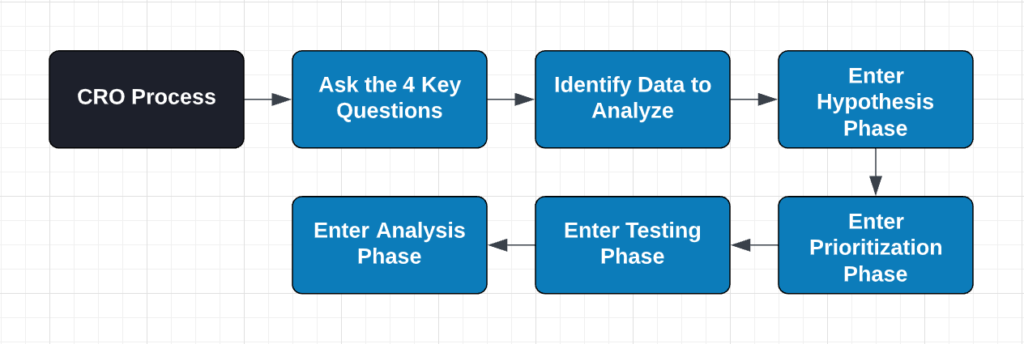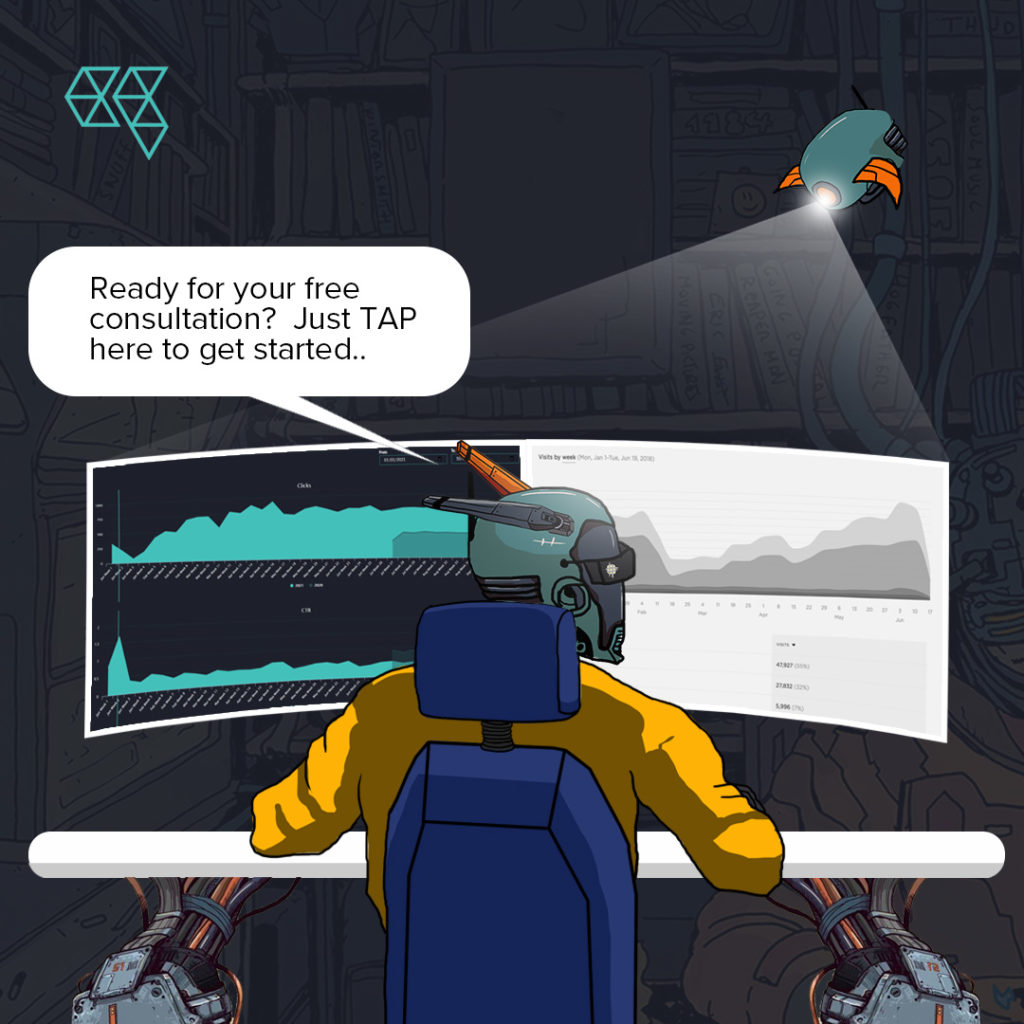Why is Conversion Rate Optimization Important?
By now, you probably have realized it’s becoming more expensive to market a website on platforms like Google, Facebook, Instagram, TikTok, and more.
You could say this is the problem we solve here at Convert4.
Although we’re still seeing these platforms return 2x to 14x (depending on the service or product offered and market competition), it’s becoming increasing crowded with new advertisers and box giants overwhelming the space with their ever-growing ad budgets.
Typically this “problem” is out of our control.
However, with conversion rate optimization, we’re able to seize back some of that power & move important marketing KPI’s like:
- CPC – Cost per click or the amount you spend to have a targeted user click on your ad.
- CTR – Click-through rate or the rate at which someone has seen your ad and takes an action by clicking through.
And website KPI’s like:
- CPA – Cost per acquisition or the amount of money you need to spend to acquire a new client or sell your product/service.
Conversion rate optimization or CRO for short, is the only option we have left.

How Does Conversion Rate Optimization Work?
Conversion rate optimization works best in two key areas of successful marketing campaigns.
- Frontend – This is the pre-frame before your offer or product page. Most often, we’re optimizing CTR within ad campaigns to improve the rate at which your potential customers are stopping and then clicking on your ad. This helps drive down total ad costs by lowering CPC.
- Backend – This second portion happens after a user has taken an action after seeing an ad. More often than not, this is where you’re sending traffic. Here you want to focus on improving the user experience of your users to make checkout and conversion as seamless as possible. We’ll touch more on how you can do this later in this article.

How to Apply Conversion Rate Optimization (A Detailed Process)
Do you like processes? I love processes…
Here’s the process we comb through when identifying how we’re going to make a business 10x their return with us in a matter of months.
- Ask the “4 Key Questions.”
- Identify data to analyze.
- Enter hypothesis phase.
- Enter prioritization phase.
- Enter testing phase.
- Enter analysis phase.
I know there is the whole rule “Follow these 3 simple steps” yada yada but that doesn’t work here. You need six, trust me on this one and I’ll show you why.
Next up, what 4 questions you need to ask to improve the conversion of any website landing page.
The 4 Key Questions to CRO

So what questions do you need to ask to improve your conversion rates and start earning more revenue? I’m glad you asked.
- Is the data I’m looking over accurate enough?
- What has worked well in the past? Think titles, creative angles, CTA text, offer types, product and service offerings, etc.
- How well does my creative and shopping experience for my potential customers compare to my competitors?
- What are competitors running in my market and how can I be different?
By answering these 4 questions, in-depth, I’m talking pages and pages in-depth, you’ll soon identify potential correlations to capitalize on within your marketing efforts.
These correlations will allow you to draft a proper hypothesis, identify areas where by 80/20 principle will make a significant impact to your revenue, and build your “Revenue Launch Bank.”
(I speak about this later in the article, so stay tuned.)
Identify Data to Analyze
Wrong question, wrong answer.
Ever heard that phrase before? It sounds silly but most of your time should be spent ensuring that you’re asking the correct questions because wrong answers are not going to do you any good.
The sample principle can apply to hiring.
Spent more time hiring the right person, who is going to provide you with the right answers and you’ll be much better off.
Let’s look at what data to analyze.
Knowing what data to look over is half the puzzle – the other, is how correct that data is.
So, the formula would look something like this:
Solution = (accurate data points) & (specific data points)
I’d say 90% of the time during an audit and strategy we’re reviewing the following data points of a new client:
- Heatmaps (something like Hotjar to record user clicks and on-page interactions.)
- User recordings (also in Hotjar.)
- Google Analytics data like bounce rate, conversion rate, conversion volume, average order value, conversion events, etc.
- Owned traffic data like email automation and sequences, upsell and order bump opportunities, SDR scripts, etc.
By reviewing these key metrics across the above data points, we’re able to determine where the issue lies but not before we first ensure data accuracy.
Enter Hypothesis Phase

Now that you’ve asked the right questions, know what data to look over, it’s time to be a good data scientist and craft your hypotheses.
A good hypothesis consists of 3 main parts which a particular change will have a particular effect due to a particular reason. It goes like this:
- Based on the insights gathered from the analysis…
- The goal or the metric you’re aiming to improve…
- The rationale behind why you believe the change will have the desired outcome…
Here’s an example for you:
“We’re seeing only 15% of users convert on this page. I believe removing the CTA button and replacing it with a full form will result in 20% more conversion because it reduces the actions needed to be taken by the user by one.”
In this example, we can see the following:
- Based on the insights… (15% of users convert.)
- Goal or metric… (Conversions.)
- Rationale… (Because it reduces actions needed for a conversion to take place.)
A good hypothesis follows logic and consideration of data to make a scientific prediction of a future outcome. This is different than “guessing” or throwing spaghetti at the wall and hoping it sticks.
Enter Prioritization Phase
After hypotheses have been formed, it’s now time to determine which tests and experiments to run first.
As with most marketing services, there are several hundred or thousand of potential “tasks” or “busy work” we could get lost in.
It’s a deep abyss… you don’t want to get stuck down there.
To prevent this, we typically apply the P.I.E. principle which has helped tens of thousands of our conversions invest their time into areas that will drive the most significant growth to their marketing and sales efforts.
What does P.I.E. stand for and can you eat it? Technically no, but it’ll make you more money which in return, you may purchase food with… so make of that as you will.

P.I.E. Potential, Importance, Ease
- Potential – Which pages or areas that are receiving traffic have the most potential to move the needle? (Think 80/20 principle)
- Importance – Which pages or areas have the most ad spend targeted towards them or which pages have the highest organic value?
- Ease – How easy is it to make these changes to each page or area? Pages which request a complete redesign will have a lower ease score than pages just needing changes to headline copy, content hooks, offer options, or user experience simplification.
How are you doing? Still with me? We’re almost there, just two steps left and you’ll have our entire process of how we’re improving conversion rates across clients like Camping World, The-House, Let’s Get Moving Canada, etc.
Enter Testing Phase

There are a few things I’ve learned over the years performing CRO for nearly 100+ businesses now and it comes down to these 9 things.
- There must be enough traffic to determine statistical significance.
- The test must run long enough to be free of peeking errors and random variants or the data may be skewed.
- Are you going to be running A/B, split, or multivariate tests?
- Greater than 2 A/B tests per month.
- Do not stop testing after a failed test.
- Do not run multiple tests at the same time with overlapping traffic. – skewed data.
- Do not run a test for less than a full week. – bad sampling and skewed data.
- Do not test your hypotheses by different time periods. – skewed data.
- Test your value propositions via ads first, then test the winning versions on landing pages.
By covering these 9 areas during your testing phase, you’re going to set yourself up for success and get to a “True Enough” result which will be as conclusive as it’s going to get in internet marketing.
Lastly, it’s time to count the cash and accept the gold medal.
Enter Analysis Phase
Here we determine a winner or loser.
Although loser often has a negative connotation, in CRO and internet marketing, a loss is more often times more valuable than a win because it tells you what the market doesn’t want.
In proper CRO campaigns, this has saved our clients millions in spend and it will likely save you money too.
Determining a winner is fairly simple and it goes like this…
Determining a Winning Test
- What was the total cost of deploying the changes?
- Does the increase in revenue or reduction in CPL supersede the total cost of deploying the changes?
If you can answer “YES” to question number two, congratulations, you’ve now created a better converting asset which will return month after month after month.
How to Determine a Losing Test
Remember what I said above about how losing isn’t a bad thing? Here’s the checklist to be actioned on after a losing test has been found.
- Look at the research; ensure the hypothesis isn’t faulty.
- Analyze the test data; do segmentation to reveal further insights.
- Validate research data with surveys and visual analytics.
- Go through relevant case studies; it could reveal new perspectives.
- Reconstruct the hypothesis to accommodate new insights that were missed in the initial research.
- Go back to testing.

